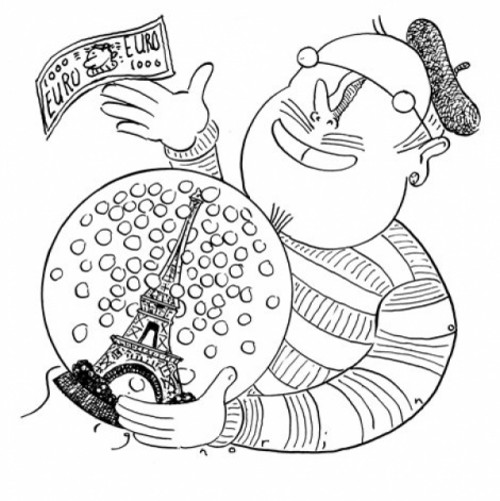A shallow individual might venture that it’s a tower named after a guy called Eiffel. (I don’t mean to give short shrift to the possibility of a Ms. Eiffel, but female tower-builders weren’t numerous in 19th-century France.) And in fact, the prime mover behind the Eiffel Tower was the French structural engineer Gustave Eiffel, who also designed the interior framework for the Statue of Liberty.
Nonetheless, Sweety, I join you in believing such an answer leaves important aspects of the subject unexplored. Popular reference works are no help. For example, if we turn to Wikipedia, we learn “the tower was built as the entrance arch to the 1889 World’s Fair,” or, as the French, in their parochial way, preferred to express it, l’Exposition universelle de 1889. The Eiffel Tower stands at one end of the Champs de Mars, a large green space in central Paris commonly used for such public spectacles. Cross the Seine, perambulate respectfully beneath the tower, and there you are.
But come on. The Eiffel Tower is 324 meters tall (including antennas mounted on top; see below), which we backward Americans think of as 1,063 feet. The structure consists of 18,038 pieces of iron, painstakingly fabricated and assembled over a two-year period. It cost nearly 8 million francs, worth something like $40 million U.S. today. In an era of trillion-dollar deficits, I suppose that’s not so much. However, it’s more than you’d expect to pay for a front gate.
Granted, for a world’s fair you want something nice. No one is going to travel from the provinces of France, to say nothing of the far reaches of the earth, to see an entrance arch that might have been bought on sale at Menard’s. Still, grand is one thing, extravagant is another. The reigning tallest structure in the world at the time, the Washington Monument, was a mere 169 meters (555 feet) in height, and as of 1890 the tallest conventional building, meaning one you could work or live in, was the New York World Building, at a puny 94 meters (309 feet).
A more economical people than the French, therefore, might have said: if we were to erect a tower of 200 meters rather than 300-plus, we’d accomplish our primary objectives—having an entrance arch, securing our place in the record books and dazzling the rustics—while nonetheless leaving ourselves a sizable sum that we might prudently invest in treasury bonds.
But they didn’t. Eiffel’s pitch for the project was specifically that he could build a 300-meter tower, and the expo planners bought it. Fact is, the Eiffel Tower arguably holds the record for ratio of grandiosity to usefulness of any structure in the world. (Some will say the Statue of Liberty comes close, but let’s remember who dreamed that up.)
This is a matter worth pondering. People have been building tall structures since the days of Babylon—mostly for the glory, of course, but usually with some ostensible higher purpose in mind. Temples and cathedrals celebrate the divine; the pyramids are tombs; the Washington Monument commemorates the first U.S. president. The tallest building in the world at the moment, the 160-story Burj Khalifa in Dubai in the United Arab Emirates, is 828 meters tall (2,717 feet). One suspects this is somewhat larger than was demanded by the local real estate market, but the fact remains that the Burj Khalifa is a building, containing habitable space.
Not so the Eiffel Tower—at least, not to any great extent. It was vanity architecture in close to pure form. That’s not to say it was a sinkhole financially. The tower has an observation deck, restaurants, a meeting space, a souvenir shop, and so on, all of which charge appropriately lofty rates. The tower earned back most of its construction cost during the 1889 exhibition; add in a subsidy from the city of Paris, and the project finished comfortably in the black.
However, business dropped off after the fair closed. The original plan was to demolish the tower after 20 years; it survived primarily because enterprising parties found practical uses for it. Rare is the visitor, gazing at the tower’s famous silhouette, who hasn’t thought: this would be the perfect spot to park my dirigible. In reality, however, tall structures make notoriously bad airship anchorages, due to buffeting winds. The tower did serve as an airship pylon on at least one occasion, when aviation pioneer Alberto Santos-Dumont rounded it during a prize-winning flight in 1901.
The salvation of the Eiffel Tower proved to be in communications. An antenna for wireless telegraphy was added in 1906; later, commercial radio and TV antennas were installed. These paid the upkeep until tourism took off after World War II. Today, the Eiffel Tower is said to draw more visitors than any other fee-charging attraction on earth, admirably serving the role for which it was built. Which is what, you ask? Don’t be dull. It’s an advertisement for France.
Send questions to Cecil via StraightDope.com or write him c/o Chicago Reader, 11 E. Illinois, Chicago 60611. Subscribe to the Straight Dope podcast at the iTunes Store.
More by Cecil Adams
-
This Is the End, My Friend
This week's Straight Dope marks the last appearance of the column as the Teeming Millions have known it for the past 45 years.
- Jul 11, 2018
-
Do Brain Supplements Do Anything?
Brain Drain
- Jul 4, 2018
-
Is flying really worse for the environment than driving?
Planes and Trains
- Jun 27, 2018
- More »




